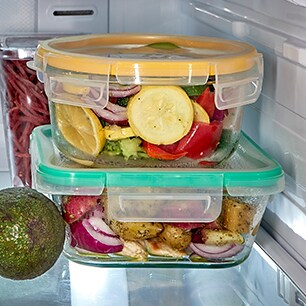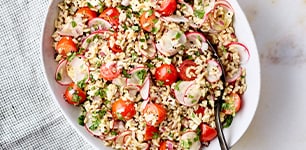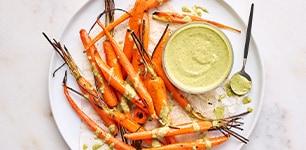Published April 1, 2021
Even though food waste happens at all points of the supply chain, we can do more to help prevent it. There’s a fine line between food waste and garbage. According to the Environmental Protection Agency (EPA), food waste is any type of food that was not used for its intended purposes.1

Food waste includes:
- Food that is served but not eaten
- Uneaten leftovers
- Discarded produce that’s over or under ripe
- Safe and edible foods perceived as spoiled
Throwing away those less-than-fresh apples can add up over time. In 2018, it was estimated that the number-one contributor to landfills and combustion facilities was food—the same food we throw away every day.2
Instead of using these foods to feed people or animals, it rotted in landfills and produced enough methane gas to account for 20% of emissions. The time and energy to plant, grow, and transport these foods were also wasted. If you’ve ever planted a garden, you know how much time, money, and supplies it takes to keep it growing.2
What can we do?
Start in the kitchen with these more sustainable practices.
- Schedule a day each week to review your refrigerator. Look for perishable foods that may spoil if not eaten right way. Figure out how to use and not waste them.
- Make a dedicated space for your reusable containers and jars. Don’t forget the matching lids. Use masking tape, markers, and freezer paper to label contents with dates. Staying prepared and organized can help save foods for later.
- Get a better understanding of best by, use by, and sell by terminology and dates by reading this quick article.
- Download the free USDA FoodKeeper App. It has step-by-step guidance on food safety, storage, and recalls. Or download this Refrigerator and Freezer Storage Chart.
- Keep track of the foods you continually throw out. Post a list of ways to reuse them on your refrigerator.
- Before traveling, repurpose the food in your fridge so it won’t have to be thrown out when you get back.
- Reorganize your freezer and refrigerator following proper food storage guidelines. Storing food properly helps maintain freshness for more time to enjoy.
- Challenge yourself to prepare one meal using these root-to-stem cooking techniques.
- Used coffee grounds and eggshells can be composted into fertilizer for your garden. Learn more about composting here.
Freeze today. Enjoy tomorrow.
Storing these foods in the freezer can help them last longer. Be sure to use freezer-safe storing containers. Many can be used frozen in smoothies or thawed for soups, stews, and toppings.
Optimal freezing times for best quality. If product has a use-by date, follow that date. If product has a sell-by date or no date, use the product by the times on the visual below or visit foodsafety.gov.
Freeze for freshness
- Kale: 10–12 months
- Broth or stock: 2–3 months
- Milk: Up to 3 months
- Bananas: 2–3 months
- Broccoli: Up to 12 months
Fresh ideas for leftover foods.
- Spinach, peppers, onions, and broccoli can be thrown into scrambled eggs, egg frittatas, omelets, or pizza toppings.
- Turn stale bread into bread crumbs or croutons.
- Make pickled toppings for tacos and burgers with cucumbers, carrots, and sweet peppers.
- Slightly overripe apples can be used in pancakes, muffins, bread, applesauce, apple butter, and more.
We walk the walk.
As our founder, Mr. George, would say, “Publix will be a little better place to work, or not quite as good, because of you." That’s how we feel about our planet. We can make it better for future generations when we all work together.
- Read about how we walk the walk in each of our departments to reduce plastic, electricity, food waste, and more.
- See how we are committed to seafood sustainability, and look for responsibly sourced and sustainably sourced icons throughout our Seafood department.
- Every April 22, we make a commitment and take actionable steps to keep the earth a wonderful place for future generations.
For the love of you.
Choosing how you eat is uniquely personal. It’s about your needs, your preferences, and your goals. As your wellness ally, we’re in your corner with fresh ideas, recipes, and wellness icons that make it easier to shift toward wiser food choices. It’s all about you, at your very best.
Sources
1 "Sustainable Management of Food Basics." United States Environmental Protection Agency (EPA). Accessed January 14, 2021.
2 "United States 2030 Food Loss and Waste Reduction Goal." United States Environmental Protection Agency (EPA). Accessed January 14, 2021.

 You are about to leave publix.com and enter the Instacart site that they operate and control. Publix’s delivery and curbside pickup item prices are higher than item prices in physical store locations. Prices are based on data collected in store and are subject to delays and errors. Fees, tips & taxes may apply. Subject to terms & availability. Publix Liquors orders cannot be combined with grocery delivery. Drink Responsibly. Be 21. For prescription delivery, log in to your pharmacy account by using the Publix Pharmacy app or visiting
You are about to leave publix.com and enter the Instacart site that they operate and control. Publix’s delivery and curbside pickup item prices are higher than item prices in physical store locations. Prices are based on data collected in store and are subject to delays and errors. Fees, tips & taxes may apply. Subject to terms & availability. Publix Liquors orders cannot be combined with grocery delivery. Drink Responsibly. Be 21. For prescription delivery, log in to your pharmacy account by using the Publix Pharmacy app or visiting 
